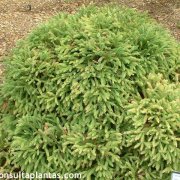Care of the tree Cryptomeria japonica or Japanese cedar |
|
The genus Cryptomeria, family Cupressaceae, includes a single species of tree native to Japan: Cryptomeria japonica. Common names: Japanese cedar, Japanese redwood. They are large trees with reddish bark and slow growth that reach 70 meters (230 feet) in height; there are small varieties of shrubby habit. The habit is compact and the feathery foliage is made up of thin acicular light green leaves that can turn bronze or purple in autumn and winter. The flowers are not decorative. Japanese cedar is used in rockery, as isolated specimens or in bushy groups combined with Juniperus and Erica. Cryptomeria japonica can grow in full sun or semi-shade exposures; in Mediterranean climates it is better to place it in semi-shade. It has good resistance to frost. It's important that the soil is well drained; they can grow on slightly calcareous or slightly acid soils. Water regularly so that the soil does not dry out completely (never overwater). The humidity must be medium or high. Fertilize in fall with compost or manure. Japanese redwood can be pruned in early spring to remove dead branches or keep them compact. Cryptomeria japonica is a resistant plant to the usual pests and diseases. Japanese cedar propagates by seeds sown in spring but it's a slow process. They also reproduce by cuttings in late winter. |
Images of the tree Cryptomeria japonica or Japanese cedar |
Find plants
Cryptomeria japonica or Japanese cedar | Care and Growing
© 2025 FavThemes
